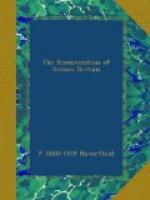The Celtic revival was due to many influences. We may find one cause for it in the Celtic environment of the province. After 407 the Romanized area was cut off from Rome. Its nearest neighbours were now the less-Romanized Britons of districts like Cornwall and the foreign Celts of Ireland and the north. These were weighty influences in favour of a Celtic revival. And they were all the more potent because, in or even before the period under discussion, the opening of the fifth century, a Celtic migration seems to have set in from the Irish coasts. The details of this migration are unknown, and the few traces which survive of it are faint and not altogether intelligible. The principal movement was that of the Scotti from North Ireland into Caledonia, with the result that, once settled there, or perhaps rather in the course of settling there, they went on to pillage Roman Britain. There were also movements in the south, but apparently on a smaller scale and a more peaceful plan.[1] At a date given commonly as A.D. 265-70—though there does not seem to be any very good reason for it—the Dessi or Deisi were expelled from Meath and a part of them settled in the south-west of Wales, in the land then called Demetia. This was a region which was both thinly inhabited and imperfectly Romanized. In it fugitives from Ireland might easily find room. The settlement may have been formed, as Professor Bury suggests, with the consent of the Imperial Government and under conditions of service. But we are entirely ignorant whether these exiles from Ireland numbered tens or scores or hundreds, and this uncertainty renders speculation dangerous. If the newcomers were few and their new homes were in the remote west beyond Carmarthen (Maridunum), formal consent would hardly have been required. Other Irish immigrants probably followed. Their settlements were apparently confined to Cornwall and the south-west coast of Wales, and their influence may easily be overrated. Some, indeed, came as enemies, though perhaps rather as enemies to the Roman than to the Celtic elements in the province. Such must have been Niall of the Nine Hostages, who was killed—according to the traditional chronology—about A.D. 405 on the British coast and perhaps in the Channel itself.
[Footnote 1: Professor Rhys, Cambrian Archaeol. Assoc. Kerry Meeting, 1891, and Celtic Britain (ed. 3, 1904, p. 247), is inclined to minimize the invasions of southern Britain (Cornwall and Wales). Professor Bury (Life of St. Patrick, p. 288) tends to emphasize them; see also Zimmer, Nennius Vindicatus, pp. 84 foll., and Kuno Meyer, Cymmrodorion Transactions, 1895-6, pp. 55 foll. The decision of the question seems to depend upon whether we should regard the Goidelic elements visible in western Britain as due in part to an original Goidelic population or ascribe them wholly to Irish immigrants. At present philologists do not seem able to speak with certainty on this point. But the evidence for some amount of invasion seems adequate.]




